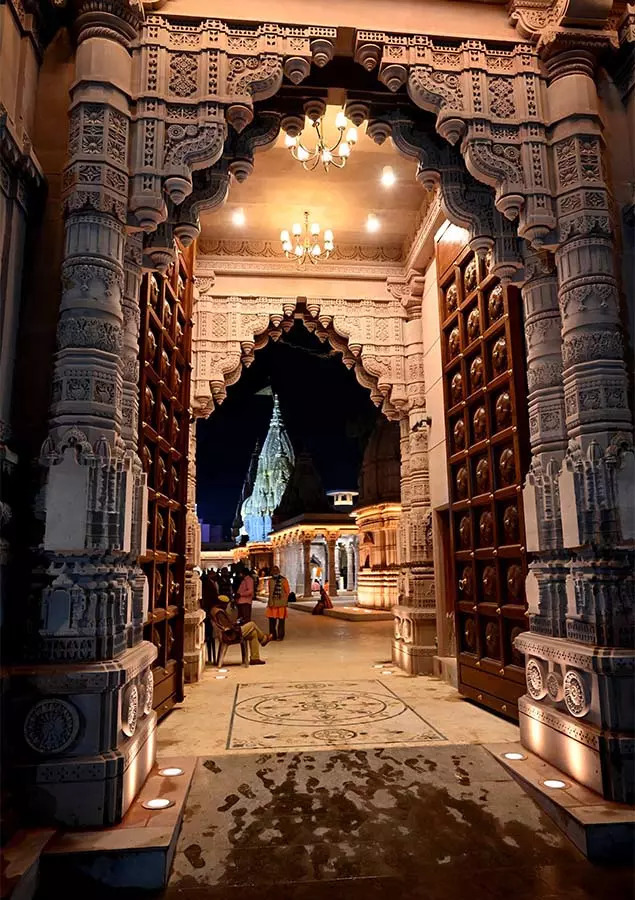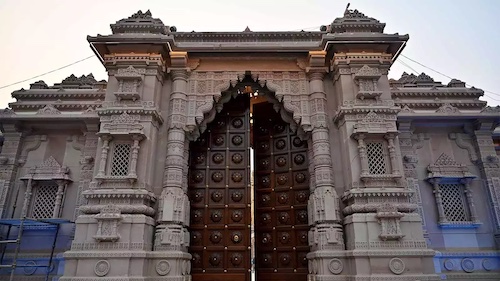Varanasi: Kashi Vishwanath
This is a collection of articles archived for the excellence of their content. Additional information may please be sent as messages to the Facebook community, Indpaedia.com. All information used will be gratefully acknowledged in your name.
This is a collection of articles archived for the excellence of their content. |
The 2021 makeover
Dec 13, 2021: The Times of India

From: Dec 13, 2021: The Times of India

From: Dec 13, 2021: The Times of India

From: Dec 13, 2021: The Times of India

From: Dec 13, 2021: The Times of India

From: Dec 13, 2021: The Times of India
Keeping an eye on assembly polls in Uttar Pradesh scheduled early next year, a major cultural outreach exercise has been planned. A galaxy of BJP leaders, including chief ministers of various states, and 3,000 seers, spiritual gurus and other dignitaries are present for the grand ceremony that is being live-streamed at 51,000 different locations across the country.
How the project was executed
Built over a sprawling area of 5,000 hectares, the corridor has decongested the temple complex, which was earlier surrounded by buildings on three sides.
With a paved 400-metre-long and 75-metre-wide corridor, the ambitious project worth more than Rs 900 crore, connects the two things Varanasi is famous for without having to go around the congested lanes — Kashi Vishwanath Temple and river Ganga. “Now the Ganga ghat will be easily visible from the temple,” a priest at the temple said.
To start with, some 320 buildings were identified, purchased and subsequently demolished to build the corridor, following which the PM laid the foundation of the mega project on March 8, 2019. At least 1,100 persons were rehabilitated to other areas. A sum of about Rs 450 crore was spent on the purchase of buildings.
Varanasi divisional commissioner Deepak Agarwal said that when the project was conceptualised it was considered an impossible task considering the dense structure of the temple premises. “However, with dedicated efforts, and despite two waves of Covid-19 pandemic, the entire process was completed in record time with utmost transparency. The Kashi Vishwanath Special Area Development Board (KVSADB) took forward the project on a war-footing right from getting the properties vacated to compensating the owners,” he said.
The idea behind the project has been to preserve existing heritage structures, provide new facilities in the complex in the public-private partnership mode, ease the traffic and movement of people around the temple, and connect the temple with ghats.
The demolition of buildings around the temple also led to the discovery of 43 ancient temples that were buried under other construction and are now part of the complex. According to Agarwal, "people had built kitchens, bathrooms and other structures atop these ancient temples. Now, these centuries-old ancient temples, which were earlier hidden, are open to the public.”
Kashi temple: Before the renovation
Entry to the Kashi Vishwanath Temple was messy and congested before redevelopment of the area
Architect of the project, Bimal Patel, also in charge of the Central Vista redevelopment project in New Delhi, said that without tampering with the original structure of the temple, beautification work was carried out and world-class facilities had been put in place.
These include easy pedestrian movement, less travel time, comfortable holding zones, crowd management, Varanasi city gallery, museum, multipurpose auditoriums, devotee facilitation centre, and overall a better experience around the religious rituals. All key stretches have also been made accessible to differently-abled people.
Varanasi is also a city where many come to spend their last days. Hindu scriptures say that dying here and getting cremated along the banks of the Ganga allows you to break the cycle of rebirth and attain salvation. A new Mumukshu Bhavan (hospice) has been constructed between the Kashi Vishwanath temple and Manikarnika Ghat in the Kashi Vishwanath Dham premises.
The inauguration The BJP has roped in its entire organisational machinery, including ministers, state leaders, MLAs and MPs to celebrate the event. UP BJP chief Swatantra Dev Singh said the programmes are being live-streamed in villages via LED screens installed at 28,000 shakti kendras (earlier known as BJP’s organisational sectors). Live-streaming will also be done at prominent temples in other states of the country, including the Somnath Temple in Gujarat.
While the main days of the celebration are from December 12 to 14, a host of programmes are being rolled out spanning over a month till Makar Sankranti on January 14, 2022. On December 13, the day of the inauguration, the state government is organising a laser show in Varanasi. Crossings, streets and other public places will be illuminated from December 12-14. All boats will be decked up for the occasion. The state government will also ensure uninterrupted power supply to the city between December 12 and 14.
The revamped Kashi Vishwanath Dham
A new identity for Kashi
The ancient Kashi Vishwanath Temple was demolished by invaders and rebuilt several times in between 1194 and 1777. In 1777, the temple was rebuilt by Ahilyabai Holkar, the queen of Indore. In 1835, Maharaja Ranjit Singh of Punjab offered 1,000 kg gold for the plating of its dome.
The latest revamp of the area aims to give a new identity to Kashi as a centre of cultural, religious and national reawakening, while also giving it the tag of a clean and smart city. Besides being the permanent abode of Lord Shiva, idols of Bharat Mata, Rani Ahilyabai who reconstructed the temple in 1776-77, Lord Kartikeya and Adi Shankaracharya are also being installed on the Dham's campus.
That's not all – standing in queues for hours for ‘darshan’ of Kashi Vishwanath will be a thing of the past. Agarwal said an IT company had been hired to work on solutions based on algorithms of footfalls on peak, non-peak and special days. “We are working on an IT solution which would give you a half an hour window within which your number will come up.”
Expected footfalls of nearly 40,000 are expected on the weekend and nearly three lakh on peak days such as ‘Maha Shivratri’ and ‘Saavan’. Millions of devotees visit the religious site every year.
Why this inauguration day is special to Lord Shiva
Coincidence or not, the inauguration happens to be taking place on a ‘Somvar’ (Monday), a day devoted to Lord Shiva. “The belief is that if one worships Lord Shiva on Mondays, you can rid yourself of all troubles," newly-nominated chairman of the Kashi Vishwanath Temple Trust (KVTT), Professor Nagendra Pandey, a noted Sanskrit scholar and astrologer, said.
So how did Shiva come to be associated with the moon? According to a legend, King Daksha, father-in-law of Chandrama (moon god), cursed the latter for not giving attention to all of Daksha's 27 adopted daughters whom he had married. Because of Daksha’s curse, Chandrama gradually started losing his glow and began shrinking in size. Fearing he would cease to exist, Chandrama offered prayers to Lord Shiva until the latter was pleased by his devotion. But Shiva couldn’t revoke Daksha's curse entirely, so he blessed Chandrama with the power to retain his form gradually again.